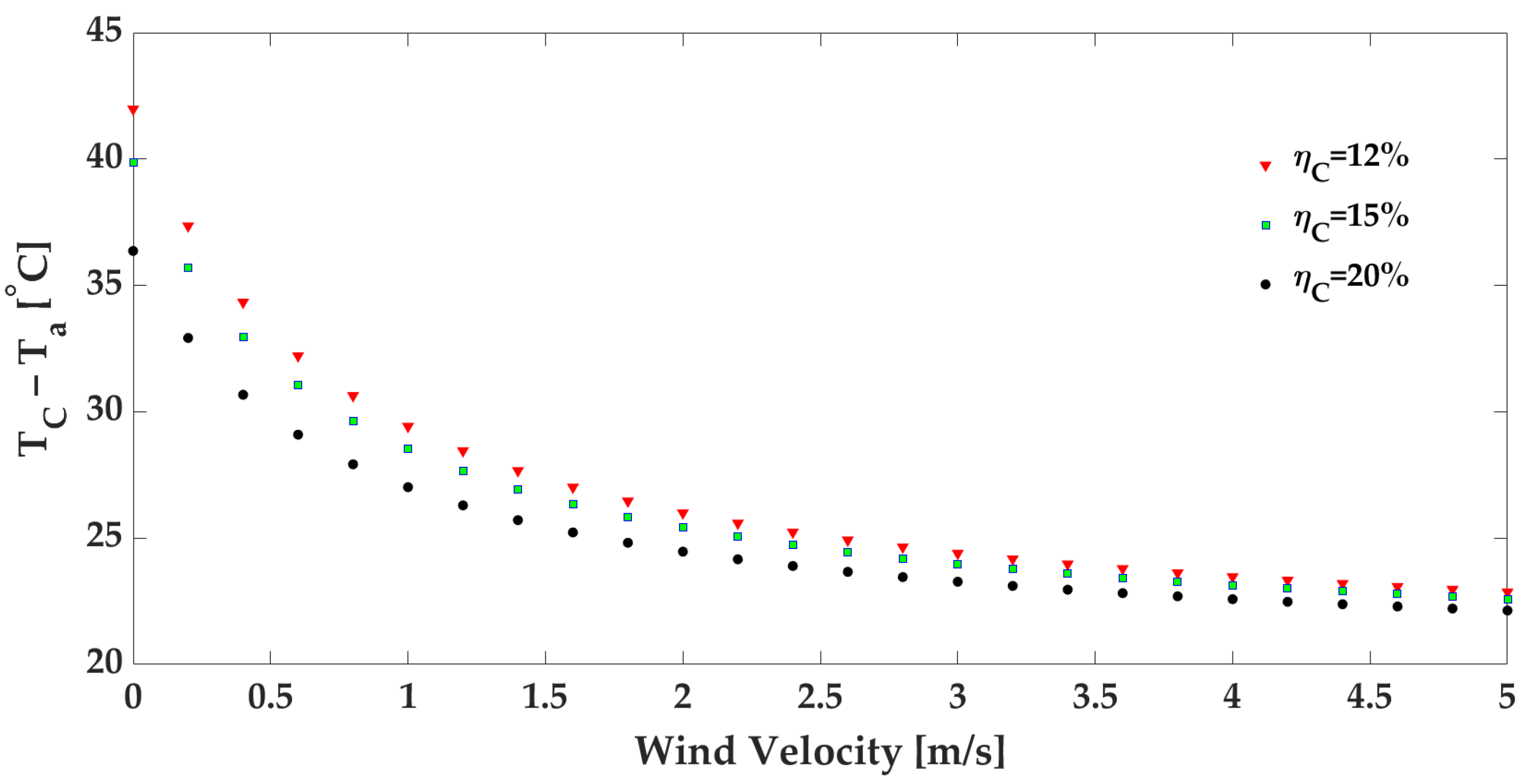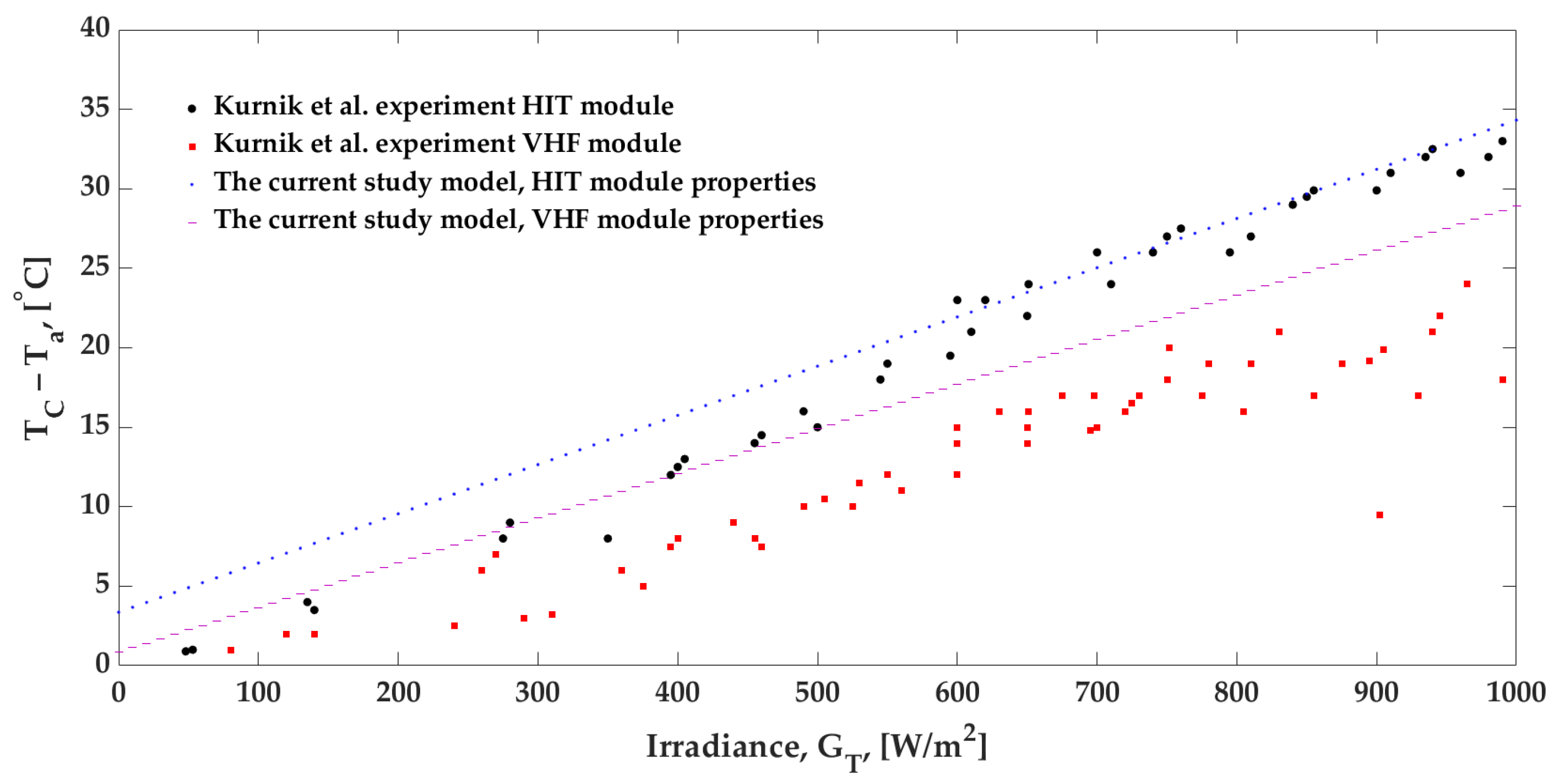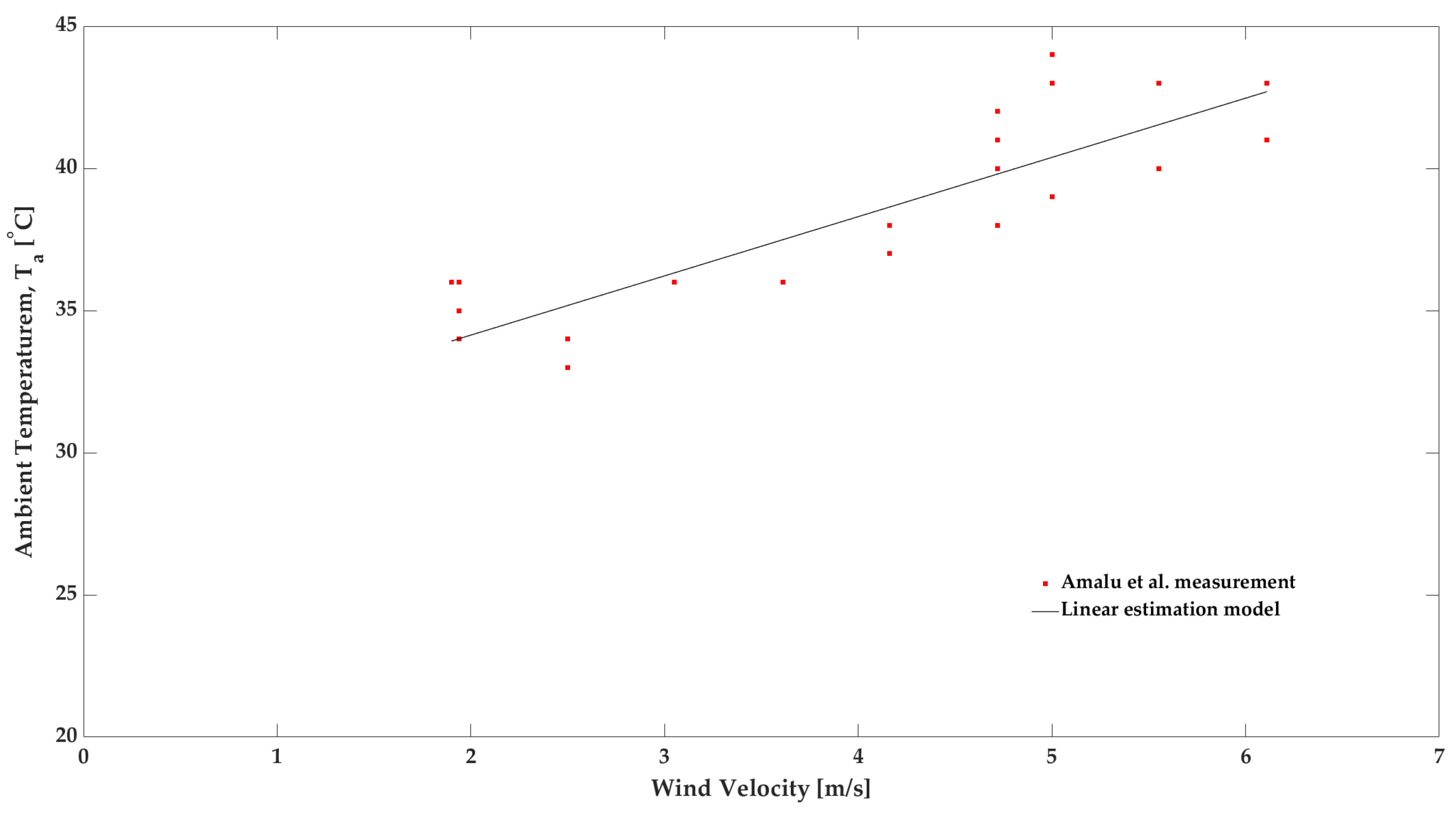Wind Velocity and Forced Heat Transfer Model for Photovoltaic Module
Abstract
:1. Introduction
- Physical and thermal properties of photovoltaic cells: Detailed information regarding the physical and thermal characteristics of the photovoltaic cells themselves is crucial. This includes properties like material composition, thermal conductivity, and heat capacity.
- Solar radiation and meteorological information: Accurate data on solar radiation levels and meteorological conditions are indispensable. These factors include solar irradiance, ambient temperature, wind speed, and humidity.
- Heat transfer coefficients for convection and radiation: Understanding the heat transfer coefficients for both convection and radiation is essential. These coefficients determine how heat is exchanged between the photovoltaic module’s surface and its surroundings.
2. Theory
2.1. PV Module Temperature and Wind Speed
- Assuming steady-state conditions [22];
- Demonstrating that Equation (5) shows a linear connection between and , although with a minor error of about 2 to 3 °C when estimating the temperature of the solar panel. This error becomes noticeable when the sunlight intensity is at 600 W/m, is 0.9, and is assumed to be zero due to the absence of a load condition [3,6].
2.2. Convection Because of Wind Speed
2.3. NOCT Condition and Convection Model of Wind Speed
2.4. Ambient Temperature Variation in PV Module Condition
3. Results and Discussion
3.1. PV Module Heat Transfer Coefficient and Wind Velocity
3.2. NOCT Model with Various Irradiance and Wind-Heat Transfer
3.3. Ambient Temperature Effectiveness in Heat Transfer of PV Module
4. Conclusions
Author Contributions
Funding
Data Availability Statement
Acknowledgments
Conflicts of Interest
References
- Hassanian, R.; Riedel, M.; Helgadottir, A.; Yeganeh, N.; Unnthorsson, R. Implicit Equation for Photovoltaic Module Temperature and Efficiency via Heat Transfer Computational Model. Thermo 2022, 2, 39–55. [Google Scholar] [CrossRef]
- Hassanian, R.; Riedel, M.; Yeganeh, N.; Helgadóttir, A. A Novel Implicit Model Determines the Photovoltaic Panel Temperature and Environmental Effects. In Proceedings of the APS March Meeting 2023, Bulletin of the American Physical Society, Las Vegas, NV, USA, 5–10 March 2023; p. D45.00013. Available online: https://meetings.aps.org/Meeting/MAR23/Session/D45.13 (accessed on 22 October 2023).
- Duffie, J.A.; Beckman, W.A.; Blair, N. Solar Engineering of Thermal Processes, 4th ed.; Wiley: New York, NY, USA, 2020. [Google Scholar]
- Luque, A. Solar Cells and Optics for Photovoltaic Concentration; CRC Press: New York, NY, USA, 1989. [Google Scholar]
- Hassanian, R.; Riedel, M.; Yeganeh, N.; Unnthorsson, R. A Practical Approach for Estimating the Optimum Tilt Angle of a Photovoltaic Panel for a Long Period—Experimental Recorded Data. Solar 2021, 1, 41–51. [Google Scholar] [CrossRef]
- Palyvos, J. A survey of wind convection coefficient correlations for building envelope energy systems’ modeling. Appl. Therm. Eng. 2008, 28, 801–808. [Google Scholar] [CrossRef]
- Bayrak, F.; Oztop, H.F.; Selimefendigil, F. Effects of different fin parameters on temperature and efficiency for cooling of photovoltaic panels under natural convection. Sol. Energy 2019, 188, 484–494. [Google Scholar] [CrossRef]
- Mehdi, M.; Ammari, N.; Alami Merrouni, A.; Benazzouz, A.; Dahmani, M. Experimental investigation on the effect of wind as a natural cooling agent for photovoltaic power plants in desert locations. Case Stud. Therm. Eng. 2023, 47, 103038. [Google Scholar] [CrossRef]
- Hudișteanu, S.V.; Țurcanu, F.E.; Cherecheș, N.C.; Popovici, C.G.; Verdeș, M.; Ancaș, D.A.; Hudișteanu, I. Effect of Wind Direction and Velocity on PV Panels Cooling with Perforated Heat Sinks. Appl. Sci. 2022, 12, 9665. [Google Scholar] [CrossRef]
- Aly, S.P.; Ahzi, S.; Barth, N.; Abdallah, A. Using energy balance method to study the thermal behavior of PV panels under time-varying field conditions. Energy Convers. Manag. 2018, 175, 246–262. [Google Scholar] [CrossRef]
- Notton, G.; Cristofari, C.; Mattei, M.; Poggi, P. Modelling of a double-glass photovoltaic module using finite differences. Appl. Therm. Eng. 2005, 25, 2854–2877. [Google Scholar] [CrossRef]
- Bevilacqua, P.; Perrella, S.; Bruno, R.; Arcuri, N. An accurate thermal model for the PV electric generation prediction: Long-term validation in different climatic conditions. Renew. Energy 2021, 163, 1092–1112. [Google Scholar] [CrossRef]
- Nicoletti, F.; Cucumo, M.A.; Ferraro, V.; Kaliakatsos, D.; Gigliotti, A. A Thermal Model to Estimate PV Electrical Power and Temperature Profile along Panel Thickness. Energies 2022, 15, 7577. [Google Scholar] [CrossRef]
- Hassanian, R.; Helgadóttir, A.; Bouhlali, L.; Riedel, M. An experiment generates a specified mean strained rate turbulent flow: Dynamics of particles. Phys. Fluids 2023, 35, 015124. [Google Scholar] [CrossRef]
- Hassanian, R.; Helgadóttir, A.; Aach, M.; Lintermann, A.; Riedel, M. A proposed hybrid two-stage DL-HPC method for wind speed forecasting: Using the first average forecast output for long-term forecasting. In Proceedings of the IACM Computational Fluids Conference, CFC 2023, Cannes, France, 25–28 April 2023. [Google Scholar]
- Hassanian, R.; Riedel, M.; Bouhlali, L. The Capability of Recurrent Neural Networks to Predict Turbulence Flow via Spatiotemporal Features. In Proceedings of the 2022 IEEE 10th Jubilee International Conference on Computational Cybernetics and Cyber-Medical Systems (ICCC), Reykjavik, Iceland, 6–9 July 2022; pp. 000335–000338. [Google Scholar]
- Hassanian, R.; Helgadóttir, A.; Riedel, M. Deep Learning Forecasts a Strained Turbulent Flow Velocity Field in Temporal Lagrangian Framework: Comparison of LSTM and GRU. Fluids 2022, 7, 344. [Google Scholar] [CrossRef]
- Hassanian, R.; Myneni, H.; Helgadóttir, A.; Riedel, M. Deciphering the dynamics of distorted turbulent flows: Lagrangian particle tracking and chaos prediction through transformer-based deep learning models. Phys. Fluids 2023, 35, 075118. [Google Scholar] [CrossRef]
- Muller, M.; Marion, B.; Rodriguez, J. Evaluating the IEC 61215 Ed.3 NMOT procedure against the existing NOCT procedure with PV modules in a side-by-side configuration. In Proceedings of the 2012 38th IEEE Photovoltaic Specialists Conference, Austin, TX, USA, 3–8 June 2012; pp. 000697–000702. [Google Scholar] [CrossRef]
- Ross, R.G., Jr. Flat-plate photovoltaic array design optimization. In Proceedings of the 14th IEEE Photovoltaic Specialists Conference, San Diego, CA, USA, 7–10 January 1980; pp. 1126–1132. [Google Scholar]
- Skoplaki, E.; Palyvos, J. Operating temperature of photovoltaic modules: A survey of pertinent correlations. Renew. Energy 2009, 34, 23–29. [Google Scholar] [CrossRef]
- Hasan, A.; Sarwar, J.; Alnoman, H.; Abdelbaqi, S. Yearly energy performance of a photovoltaic-phase change material (PV-PCM) system in hot climate. Sol. Energy 2017, 146, 417–429. [Google Scholar] [CrossRef]
- Waqas, A.; Ji, J.; Xu, L.; Ali, M.; Zeashan; Alvi, J. Thermal and electrical management of photovoltaic panels using phase change materials—A review. Renew. Sustain. Energy Rev. 2018, 92, 254–271. [Google Scholar] [CrossRef]
- Negash, T.; Tadiwose, T. Experimental Investigation of the Effect of Tilt Angle on the Dust Photovoltaic Module. Int. J. Energy Power Eng. 2015, 4, 227–231. [Google Scholar] [CrossRef]
- Mamun, M.; Islam, M.; Hasanuzzaman, M.; Selvaraj, J. Effect of tilt angle on the performance and electrical parameters of a PV module: Comparative indoor and outdoor experimental investigation. Energy Built Environ. 2022, 3, 278–290. [Google Scholar] [CrossRef]
- Cengel, Y.; Ghajar, A. Heat and Mass Transfer: Fundamentals and Applications, 6th ed.; McGraw Hill: New York, NY, USA, 2019. [Google Scholar]
- Incropera, F.P.; DeWitt, D.P.; Bergman, T.L.; Lavine, A.S. Fundamentals of Heat and Mass Transfer, 6th ed.; John Wiley & Sons: New York, NY, USA, 2006. [Google Scholar]
- Holman, J. Heat Transfer; McGraw-Hill Education: New York, NY, USA, 2009. [Google Scholar]
- Ozisik, M.N. Heat Transfer: A Basic Approach; McGraw-Hill: New York, NY, USA, 1984. [Google Scholar]
- McAdams, W.H. Heat Transmission, 3rd ed.; McGraw-Hill Book Co.: New York, NY, USA, 1954. [Google Scholar]
- W, J. Gesundheits-Ingenieur; Verlag: Berlin, Germany, 1924; Volume 1. [Google Scholar]
- Watmuff, J.; Charters, W.; Proctor, D. Solar and Wind Induced External Coefficients-Solar Collectors; Cooperation Mediterraneenne pour l’Energie Solaire: Marseille, France, 1977; p. 56. [Google Scholar]
- Wen, L. An Investigation of the Effect of Wind Cooling on Photovoltaic Arrays; Jet Propulsion Laboratory: Pasadena, CA, USA, 1982. [Google Scholar]
- Kurnik, J.; Jankovec, M.; Brecl, K.; Topic, M. Outdoor testing of PV module temperature and performance under different mounting and operational conditions. Sol. Energy Mater. Sol. Cells 2011, 95, 373–376. [Google Scholar] [CrossRef]
- Jurisson, J.; Peterson, R.E.; Mar, H.Y.B. Principles and applications of selective solar coatings. J. Vac. Sci. Technol. 1975, 12, 1010–1015. [Google Scholar] [CrossRef]
- Bae, J.H.; Kim, D.Y.; Shin, J.W.; Lee, S.E.; Kim, K.C. Analysis on the Features of NOCT and NMOT Tests with Photovoltaic Module. IEEE Access 2020, 8, 151546–151554. [Google Scholar] [CrossRef]
- Amalu, E.H.; Fabunmi, O.A. Thermal control of crystalline silicon photovoltaic (c-Si PV) module using Docosane phase change material (PCM) for improved performance. Sol. Energy 2022, 234, 203–221. [Google Scholar] [CrossRef]






Disclaimer/Publisher’s Note: The statements, opinions and data contained in all publications are solely those of the individual author(s) and contributor(s) and not of MDPI and/or the editor(s). MDPI and/or the editor(s) disclaim responsibility for any injury to people or property resulting from any ideas, methods, instructions or products referred to in the content. |
© 2024 by the authors. Licensee MDPI, Basel, Switzerland. This article is an open access article distributed under the terms and conditions of the Creative Commons Attribution (CC BY) license (https://creativecommons.org/licenses/by/4.0/).
Share and Cite
Hassanian, R.; Yeganeh, N.; Riedel, M. Wind Velocity and Forced Heat Transfer Model for Photovoltaic Module. Fluids 2024, 9, 17. https://doi.org/10.3390/fluids9010017
Hassanian R, Yeganeh N, Riedel M. Wind Velocity and Forced Heat Transfer Model for Photovoltaic Module. Fluids. 2024; 9(1):17. https://doi.org/10.3390/fluids9010017
Chicago/Turabian StyleHassanian, Reza, Nashmin Yeganeh, and Morris Riedel. 2024. "Wind Velocity and Forced Heat Transfer Model for Photovoltaic Module" Fluids 9, no. 1: 17. https://doi.org/10.3390/fluids9010017






